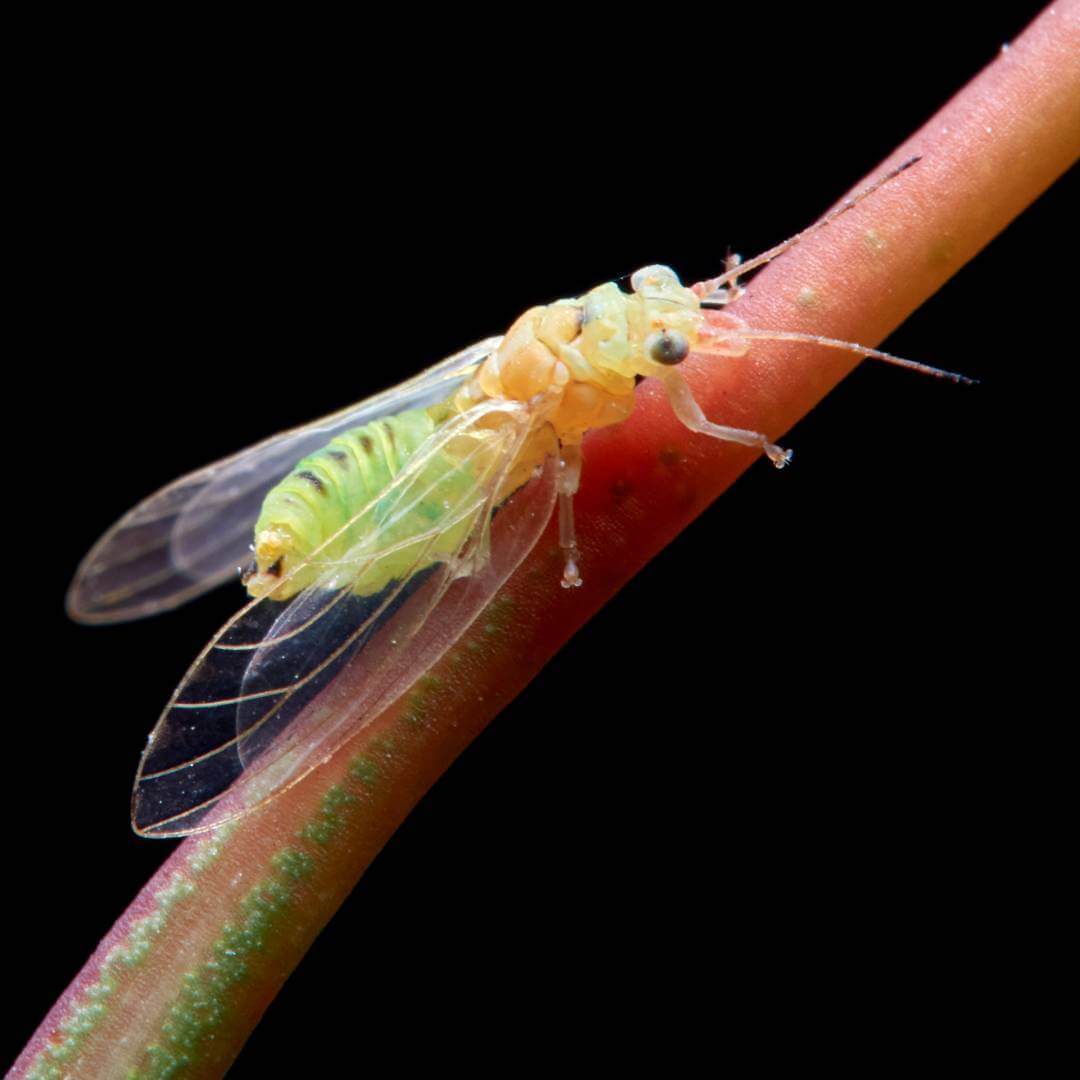Order: Hemiptera (TrueBugs)
Family: Psyllidae, Triozidae
Common Names: Plant Lice, Jumping Plant Lice, Lerps, Lerp Psyllid, Gall Psyllid, Lilly Pilly Psyllid
What are Psyllids?
Psyllids are tiny sap-sucking insects that feed on the nutrient rich liquids inside leaves and transport tissues (xylem & phloem). Most species of psyllid will only feed on one specific host plant, however some species are known to broaden their preferences to plant varieties within the same family.
They appear in the warmer months and are less prevalent in the cold.
What do Psyllids look like?
Psyllids have 3 life-cycle stages: egg, nymph and adult. Most species will go through 3 to 5 generations per year.
Adults look like a tiny, winged insect approximately 2-3mm in length, the wings pointing back over the abdomen in a V shape.
Nymphs are usually a miniature version of the adult form but without wings, more scaly and can look flattish. Some species hide under what is a called a ‘Lerp’, which is a little white, sugary covering that shields the nymph whilst it feeds and molts. Others cause pits or galls in the leaves.
Eggs are found singly or in clusters, sometimes found upon the leaf and its edges, other species insert the eggs into the leaf tissue.
What are the signs that you have Psyllids
We have 100s of species of psyllids in Australia. The most common species are the Lilly Pilly Psyllid, Lerp forming Psyllid, Gall forming Psyllid and Free Living Psyllid. These are all mostly found on our native plants and are most noticeable during the nymph stages.
Lilly Pilly Psyllid
These psyllids are often visible on the new growth of the plant. After they hatch, the nymph crawls into position on a young leaf to begin feeding and molting. After the first molt a pock mark or small pit appears on the leaf. As it grows and continues to molt, this pit becomes bigger, looking like a pimple on the leaf of the plant. The adult emerges after the final molt and the whole cycle begins again!
Waterhousia floribunda is a particularly juicy variety to the Lilly Pilly Psyllid and often gets attacked.
Damage
Cosmetic damage to the leaves, causing the leaves to curl and pimple. Severe infestation can cause some leaf drop and stunt growth but it is rare that it will kill the plant.
Gall Psyllid
Often seen on natives such as Eucalyptus, the nymphs will burrow into the leaf, causing a gall to form around it as protection. Once the nymph has reached maturity, it breaks out of the gall as an adult.
Damage
Only cosmetic, overall never getting so bad as to kill the tree.
Lerp Psyllid
These psyllids excrete a white, sugary substance to cover themselves as protection whilst they feed on the leaf of the plant. This is called a lerp. The lerp gets bigger as the nymph molts, finally emerging as an adult. Lerps are eaten by many animals such as birds, possums, flying foxes and gliders. They can even be eaten by humans as a sweet treat!
Damage
Light infestations cause a mottled appearance on the leaves, whereas a severe infestation can cause the tree to defoliate, affecting its growth and appearance. In some cases it can cause the tree to die.
Free-living Psyllid
Free-living psyllids are just that, free living! They feed on the new growth of the plant and create no protective cover like the previous psyllid types. Both the adult and nymphs are seen on the plant at the same time. They tend to target a lot of natives such as grevillea, wattles and eucalypts as well as ornamental plants such as Smoke Bush.
Damage
Can produce Sooty Mold and other waxy secretions, often deforming new growth with bad infestations.
How to get rid of Psyllids
Luckily there are many different methods for preventing and removing psyllids.
Natural Predators
Encourage the natural enemies of psyllids in your garden. These include birds, lacewings, spiders, parasitic wasps and ladybirds.
Watch for Ants!
Ants often search for honeydew, which psyllids can produce. Ants drive away natural predators, so to keep the ants away apply some horticultural glue to the trunk of the plant.
Psyllid Resistant Varieties
Instead of battling the Psyllids each year, grow plant varieties that don’t interest them! For example, instead of planting Weeping Lilly Pilly go for a more Psyllid resistant variety such as any of the Acmena variety.
Wipe Leaves
Lerps can be wiped off the leaves of Eucalypts. But keep in mind, a lot of animals also enjoy eating them! Make sure you’re not removing their food supply.
Prune
Remove infested branches and leaves of the plants and either burn the cuttings or steep in a bucket of water for a few days to drown them. They can still survive in your compost and fly out, back to the main plant.
Healthy Plants
Stressed plants, like stressed people, attract pests and diseases. Build their immune system by keeping your plants happy and healthy with regular watering and fertiliser in the growing months.
Organic Spray
Neem Oil or Insecticidal Soap will kill off most Psyllids and preserve the safety of your beneficial insects. It needs to be applied weekly to get all of them. Often, when damage is seen, the psyllids have long since done their business and left. So make sure the psyllids are still there when you spray or you’re just wasting money!
Chemical Spray
Yates Baythroid Advanced Garden Pest Insect Killer Ready to Use Spray will do much the same as Neem Oil or Insecticidal Soap but requires less applications.















